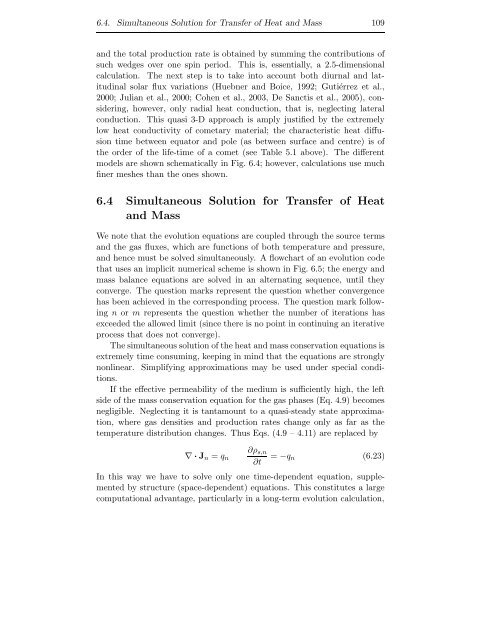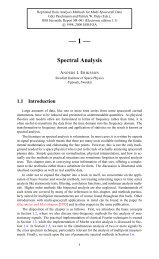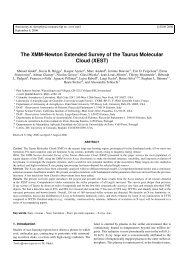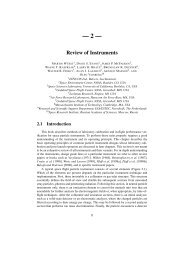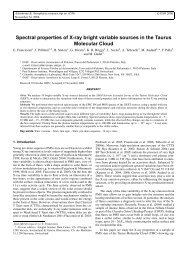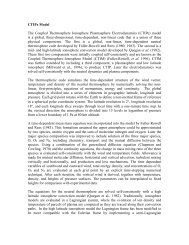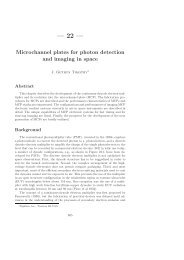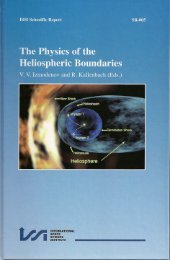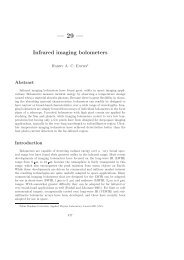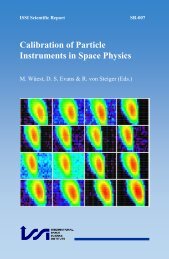Heat and Gas Diffusion in Comet Nuclei (pdf file 5.5 MB) - ISSI
Heat and Gas Diffusion in Comet Nuclei (pdf file 5.5 MB) - ISSI
Heat and Gas Diffusion in Comet Nuclei (pdf file 5.5 MB) - ISSI
You also want an ePaper? Increase the reach of your titles
YUMPU automatically turns print PDFs into web optimized ePapers that Google loves.
6.4. Simultaneous Solution for Transfer of <strong>Heat</strong> <strong>and</strong> Mass 109<br />
<strong>and</strong> the total production rate is obta<strong>in</strong>ed by summ<strong>in</strong>g the contributions of<br />
such wedges over one sp<strong>in</strong> period. This is, essentially, a 2.5-dimensional<br />
calculation. The next step is to take <strong>in</strong>to account both diurnal <strong>and</strong> latitud<strong>in</strong>al<br />
solar flux variations (Huebner <strong>and</strong> Boice, 1992; Gutiérrez et al.,<br />
2000; Julian et al., 2000; Cohen et al., 2003, De Sanctis et al., 2005), consider<strong>in</strong>g,<br />
however, only radial heat conduction, that is, neglect<strong>in</strong>g lateral<br />
conduction. This quasi 3-D approach is amply justified by the extremely<br />
low heat conductivity of cometary material; the characteristic heat diffusion<br />
time between equator <strong>and</strong> pole (as between surface <strong>and</strong> centre) is of<br />
the order of the life-time of a comet (see Table 5.1 above). The different<br />
models are shown schematically <strong>in</strong> Fig. 6.4; however, calculations use much<br />
f<strong>in</strong>er meshes than the ones shown.<br />
6.4 Simultaneous Solution for Transfer of <strong>Heat</strong><br />
<strong>and</strong> Mass<br />
We note that the evolution equations are coupled through the source terms<br />
<strong>and</strong> the gas fluxes, which are functions of both temperature <strong>and</strong> pressure,<br />
<strong>and</strong> hence must be solved simultaneously. A flowchart of an evolution code<br />
that uses an implicit numerical scheme is shown <strong>in</strong> Fig. 6.5; the energy <strong>and</strong><br />
mass balance equations are solved <strong>in</strong> an alternat<strong>in</strong>g sequence, until they<br />
converge. The question marks represent the question whether convergence<br />
has been achieved <strong>in</strong> the correspond<strong>in</strong>g process. The question mark follow<strong>in</strong>g<br />
n or m represents the question whether the number of iterations has<br />
exceeded the allowed limit (s<strong>in</strong>ce there is no po<strong>in</strong>t <strong>in</strong> cont<strong>in</strong>u<strong>in</strong>g an iterative<br />
process that does not converge).<br />
The simultaneous solution of the heat <strong>and</strong> mass conservation equations is<br />
extremely time consum<strong>in</strong>g, keep<strong>in</strong>g <strong>in</strong> m<strong>in</strong>d that the equations are strongly<br />
nonl<strong>in</strong>ear. Simplify<strong>in</strong>g approximations may be used under special conditions.<br />
If the effective permeability of the medium is sufficiently high, the left<br />
side of the mass conservation equation for the gas phases (Eq. 4.9) becomes<br />
negligible. Neglect<strong>in</strong>g it is tantamount to a quasi-steady state approximation,<br />
where gas densities <strong>and</strong> production rates change only as far as the<br />
temperature distribution changes. Thus Eqs. (4.9 – 4.11) are replaced by<br />
∇ · J n = q n<br />
∂ρ s,n<br />
∂t<br />
= −q n (6.23)<br />
In this way we have to solve only one time-dependent equation, supplemented<br />
by structure (space-dependent) equations. This constitutes a large<br />
computational advantage, particularly <strong>in</strong> a long-term evolution calculation,


